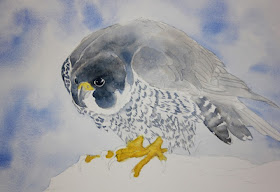When I submit an article to the Tennessee Conservationist Magazine, published by the TN Dept. of Environment and Conservation, I never know which photos will actually go into the article. I send a good selection and the editor makes the final decision. Whenever possible, I include a watercolor of the bird that is the subject of my article but it is not a given that it will be published. I was delighted to see that my watercolor, "Peregine Falcon", was included in the article that spanned five pages, and that the article also captured the cover headline!

This watercolor began with a sketch that you see below, a practice to help wrap my mind around the shapes and expression that is characteristic of this incredible falcon. I had recently encountered a falconer showing this species on my trip to Alaska at the Sandhill Crane festival in Fairbanks, giving me a great opportunity to observe the bird up-close and take some reference photos.
The Peregrine Falcon's recovery in North America is one of the greatest conservation stories in our nation's history. After the bird's devastating decline, largely due to the widespread use of DDT after WWII, the USFWS reported that there were only 324 confirmed pairs of breeding Peregrine Falcons nesting in all of North America.
In Tennessee, breeding Peregrine Falcons had disappeared by 1947 and it wasn't until 50 years later that Peregrine Falcons were again discovered breeding in the state. In the images below you can see how I approached this painting. The sky was created by wetting the paper around the falcon and applying ultramarine blue to the wet paper leaving plenty of white for clouds.
As I often do, I put some detail in the face as I worked on the feather details. I do this to make the subject come alive and add energy to the project while I work. At other times, the additional detail gives me more of an idea of how the finished painting will look and helps guide my color application and lights and darks.
Below, I begin to work on the rock surface where the Peregrine is perched. I did not have a specific reference for the rocks but did look at rock treatments by other artists to give me some ideas. I used warm colors to describe the boulder to balance the grays and blues in the bird. For the boulder detail, I followed the lines of paint to shape a natural rock surface.To finish, I added more definition and shadow to the feathers, sharper lines and individual definition to the rocks, and added some tufts of grass. (See finished painting at top). The Peregrine Falcon was one of the first species added to the endangered species list in 1973 and was finally removed in 1999. In 2012, the USFWS reported that from 2000-3000 breeding pairs of Peregrine Falcons could be found in North America.
Links and Resources:
TN Conservationist Magazine--The Peregrine Falcon in Tennessee





